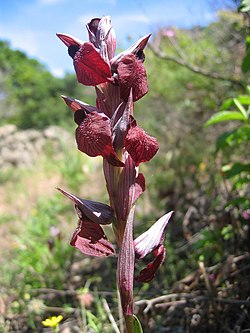| Serapias cordigera | |
|---|---|
 | |
| Flower of Serapias cordigera | |
| Scientific classification | |
| Kingdom: | Plantae |
| Clade: | Tracheophytes |
| Clade: | Angiosperms |
| Clade: | Monocots |
| Order: | Asparagales |
| Family: | Orchidaceae |
| Subfamily: | Orchidoideae |
| Genus: | Serapias |
| Species: | S. cordigera |
| Binomial name | |
| Serapias cordigera | |
| Synonyms | |
Serapias cordigera is a species of orchids found from the Azores, south-central Europe to the Mediterranean. [1]